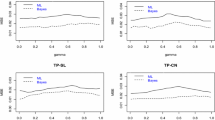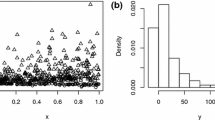Abstract
We present full Bayesian analysis of finite mixtures of multivariate normals with unknown number of components. We adopt reversible jump Markov chain Monte Carlo and we construct, in a manner similar to that of Richardson and Green (1997), split and merge moves that produce good mixing of the Markov chains. The split moves are constructed on the space of eigenvectors and eigenvalues of the current covariance matrix so that the proposed covariance matrices are positive definite. Our proposed methodology has applications in classification and discrimination as well as heterogeneity modelling. We test our algorithm with real and simulated data.
Similar content being viewed by others
References
Bottolo L., Consonni G., Dellaportas P., and Lijoi A. 2003. Bayesian analysis of extreme values by mixture modeling. Extremes 6: 25–47.
Brooks S.P., Giudici P., and Roberts G.O. 2003. Efficient construction of reversible jump Markov chain Monte Carlo proposal distributions (with Discussion). Journal of the Royal Statistical Society, Series B 65: 3–56.
Cappé O., Robert C.P., and Rydén T. 2001. Reversible jump MCMC converging to birth-and-death MCMC and more general continuous time samplers. Technical Report 65: 679–700.
Cappé O., Robert C.P., and Rydén T. 2003. Reversible jump, birth-and-death and more general continuous time Markov chain Monte Carlo samplers. Journal of the Royal Statistical Socisety, Series B 65: 679–700.
Celeux G., Hurn M., and Robert C.P. 2000. Computational and differential difficulties with mixture posterior distributions. Journal of the American Statistical Association 95: 957–70.
Consonni G. and Veronese P. 1995. A Bayesian method for combining results from several binomial experiments. Journal of the American Statistical Association 90: 935–944.
Dellaportas P. 1998. Bayesian classification of neolithic tools. Applied Statistics 47: 279–297.
Diebolt J. and Robert C.P. 1994. Estimation of finite mixture distributions through Bayesian sampling. Journal of the Royal Statistical Socisety, Series B 56: 363–375.
Fernandez C. and Green P.J. 2002. Modelling spatially correlated data via mixtures: A Bayesian approach. Journal of the Royal Statistical Socisety, Series B 64: 805–826.
Frühwirth-Schnatter S. 2001. Markov Chain Monte Carlo estimation of classical and dynamic switching and mixture models. Journal of the American Statistical Association 96: 194–209.
Green P.J. 1995. Reversible jump Markov chain Monte Carlo computation and Bayesian model determination. Biometrika 82: 711–732.
Geyer C. and Møller J. 1994. Simulation procedures and likelihood inference for spatial point processes, Scandinavian Journal of Statistics 21: 359–373.
Green P. J. and Richardson S. 2001. Modelling heterogeneity with and without the Dirichlet process. Scandinavian Journal of Statistics 28: 355–376.
Hartigan, J.A. (1990). Partition models. Communication in Statistics, Series A: Theory and Methods 19: 2745–2756.
Hurn M., Justel A., and Robert C.P. 2003. Estimating mixtures of regressions. Journal of Computational and Graphical Statistics 12: 1–25.
Jasra A., Holmes C.C., and Stephens D.A. 2005. Markov chain Monte Carlo and the label switching problem in Bayesian mixture modelling. Statistical Science 20: 5067.
Lavine M. and West M. 1992. A Bayesian method for classification and discrimination. The Canadian Journal of Statistics 20: 451–461.
Lindsay B. G. 1995. Mixture models: Theory, Geometry and Applications. Institute of Mathematical Statistics, Hayward.
Liu J. S., Zhang J.L., Palumbo M.J., and Lawrence C.E. 2003. Bayesian Clustering with Variable and Transformation Selections. Bayesian Statistics 7 (eds J.M. Bernardo, Bayarri M.J., Berger J.O., Dawid A.P., Heckerman D., Smith A.F.M. and West M.) pp. 249–275, Oxford University press, UK.
Lopes H.F., Muller P., and Rosner G.L. 2003. Bayesian Meta-analysis for Longitudinal data models using multivariate mixture priors. Biometrics 59: 66–72.
Magnus J.R. and Neudecker H. 1988. Matrix differential calculus with applications in statistics and econometrics. John Wiley and Sons, NY.
McLachlan G.J. and Basford K. E. 1988. Mixture Models: Inference and Applications to Clustering. Marcel Dekker, New York.
Møller J. and Waagepetersen R. 2003. Statistical Inference and Simulation for Spatial Point Processes Series. Monographs on Statistics and Applied Probability, Vol. 100, Chapman and Hall, UK.
Neal R. 1996. Sampling from multimodal distributions using tempered transitions. Statistics and Computing 4: 353–366.
Nobile A. and Green P.J. 2000. Bayesian analysis of factorial experiments by mixture modelling. Biometrika 87: 15–35.
Richardson S. and Green P. J. 1997. On the Bayesian analysis of mixtures with an unknown number of components (with discussion). Journal of the Royal Statistical Socisety, Series B 59: 731–792.
Robert C. P. 1996. Mixtures of distributions: Inference and estimation, Markov chain Monte Carlo in Practice (eds W.R. Gilks, S. Richardson and D.J. Spiegelhalter), pp. 441–464, Chapman and Hall, UK.
Robert C.P., Rydén T., and Titterington D.M. 2000. Bayesian inference in hidden Markov models through the reversible jump MArkov chain Monte CArlo method. Journal of the Royal Statistical Socisety, Series B 62: 57–76.
Stephens M. 2000. Dealing with label switching in mixture models. Journal of the Royal Statistical Society, Series B 62: 795–809.
Stephens M. 2000. Bayesian analysis of mixture models with an unknown number of components -an alternative to reversible jump methods. Journal of the Royal Statistical Society, Series B 62: 795–809.
Titterington D.M., Smith A. F. M., and Makov U. E. 1985. Statistical Analysis of Finite Mixture Distributions, Wiley, New York.
Tubb A., Parker A. J., and Nickless G. 1980. The Analysis of Romano-British pottery by atomic absorption spectrophotometry. Archaeometry, 22: 153–171.
Zhang Z., Chan K.L., Wu Y., and Chen C. 2004. Learning a multivariate Gaussian mixture models with the reversible jump MCMC algorithm. Statistics and Computing 14: 343–355.
Author information
Authors and Affiliations
Rights and permissions
About this article
Cite this article
Dellaportas, P., Papageorgiou, I. Multivariate mixtures of normals with unknown number of components. Stat Comput 16, 57–68 (2006). https://doi.org/10.1007/s11222-006-5338-6
Received:
Accepted:
Issue Date:
DOI: https://doi.org/10.1007/s11222-006-5338-6




